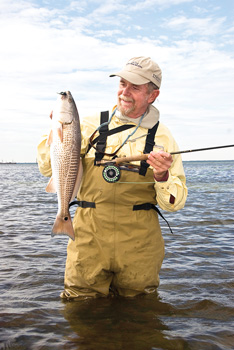Coming attraction: winter wading/hot action

submitted
Rusty Chinnis caught this redfish on an
early morning winter low tide while fishing
pot holes.
If you’re one of those fishermen who think of wade fishing as a summertime activity, you may be missing the boat. Winter wading can be extremely productive and will often give you an advantage over boat-bound anglers. When you get out of the boat and in the fish’s domain, you gain the same advantage of a silent approach that you do in the spring, summer or fall. When the water is cold it is often very clear, and the fish can be very wary. Getting in the water allows you to keep a low profile and make a stealthy approach.
When the fish are spooky and hard to see, try standing still! If you find that the fish see you just before you see them then this approach will pay dividends. Start by locating an area that is holding your quarry. Anchor well away from the action, and get out of the boat, staking out a pothole or sand area. By staying a long cast away, you can easily see the fish when they enter a hole or pass across the white sand bottom. Position yourself off to the side in the grass where you’re less visible, keep a low profile and be still. By just waiting them out, you can target reds, trout and snook as they wander the flat. Don’t make any quick moves, and make your casts low and slow. It takes patience, but can be very productive.
When wading you won’t need heavy tackle unless you’re fishing docks or other structure, limit tackle to 8-10 pound test. Make sure reels have plenty of line for long smooth casts and always check hooks for sharpness and make sure the drag is properly set. Spin and bait casting leaders should have a thirty pound bite tippet approximately five to six feet long. In clear water you might want to down size leaders to ten to fifteen pounds. This will often fool wary trout, but you’ll risk being cut off should you encounter a big snook.
If the visibility isn’t great, or you’re fishing early or late, target the edges where grass and sand meet. These sandy areas (the seams) and pot holes are perfect ambush spots for the predators you’re targeting. Start with presentations about two feet outside the sandy area. Make sure you target the deep grassy ends of the potholes. These areas can be very productive and always warrant a couple of extra casts.
After working the edges of the holes and the seams, begin casting into the sandy areas. Work the nearside of the hole and cast progressively longer until you reach the other side. When fly fishing, try a clear sink tip line with a relatively (6-8 foot) short leader. The clear tip allows you to fish the far side of a hole without spooking the fish. Thirty pound bite tippets that are twelve inches long will suffice.
Over the last two winters we have been having some excellent success with big trout on cold, low tide mornings. The fish will come into some extremely shallow water to feed, so start shallow and work your way towards the deeper edges. And always stay vigilant for surface action, wakes or feeding birds.
The key to productive and comfortable winter wading is, of course, staying warm. A good pair of waders, wading boots, sweat pants and insulating socks will do the trick. Add a pair of polarized glasses, a hat with a dark under-brim, a wade vest or pack, and you’re in business. Give winter wade fishing a try. It gets you out of the boat, provides some exercise, and some excellent angling opportunities.

